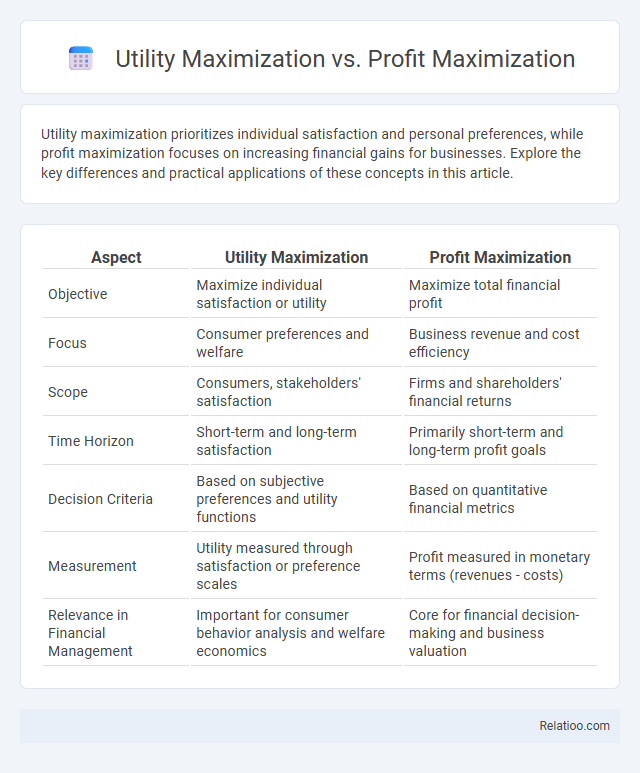Utility maximization prioritizes individual satisfaction and personal preferences, while profit maximization focuses on increasing financial gains for businesses. Explore the key differences and practical applications of these concepts in this article.
Table of Comparison
| Aspect | Utility Maximization | Profit Maximization |
|---|---|---|
| Objective | Maximize individual satisfaction or utility | Maximize total financial profit |
| Focus | Consumer preferences and welfare | Business revenue and cost efficiency |
| Scope | Consumers, stakeholders' satisfaction | Firms and shareholders' financial returns |
| Time Horizon | Short-term and long-term satisfaction | Primarily short-term and long-term profit goals |
| Decision Criteria | Based on subjective preferences and utility functions | Based on quantitative financial metrics |
| Measurement | Utility measured through satisfaction or preference scales | Profit measured in monetary terms (revenues - costs) |
| Relevance in Financial Management | Important for consumer behavior analysis and welfare economics | Core for financial decision-making and business valuation |
Introduction to Utility and Profit Maximization
Utility maximization involves individuals making choices to achieve the highest satisfaction from the consumption of goods and services, reflecting personal preferences and constraints. Profit maximization centers on firms seeking to increase the difference between total revenue and total cost to achieve the highest financial gain. Your understanding of these concepts is critical for analyzing decision-making in both consumer behavior and business strategy.
Defining Utility Maximization
Utility Maximization is an economic concept where consumers aim to achieve the highest satisfaction or happiness from their available resources by choosing combinations of goods and services. Unlike Profit Maximization, which is concerned with increasing monetary gains for firms, Utility Maximization focuses on personal well-being and preference fulfillment. This principle underpins consumer behavior models by explaining decisions based on marginal utility and budget constraints.
Understanding Profit Maximization
Profit maximization involves making decisions that increase a firm's total revenue while minimizing costs to achieve the highest possible financial gain. Unlike utility maximization, which emphasizes individual satisfaction or happiness from consuming goods and services, profit maximization centers on business objectives and financial performance. Understanding profit maximization requires analyzing marginal cost and marginal revenue to determine the optimal output level that maximizes net profit.
Core Differences Between Utility and Profit Maximization
Utility maximization focuses on optimizing individual satisfaction or preferences given constraints, while profit maximization aims to maximize a firm's financial earnings. The core difference lies in the objective: utility maximization considers consumer behavior and subjective welfare, whereas profit maximization centers on business-oriented financial gains. Utility maximization involves diverse factors beyond monetary value, whereas profit maximization strictly pertains to economic returns and cost management.
The Role of Consumer Behavior in Utility Maximization
Consumer behavior plays a critical role in utility maximization by influencing how individuals allocate their resources to achieve the highest personal satisfaction from goods and services. Unlike profit maximization, which focuses on optimizing financial returns for producers, utility maximization centers on consumers' preferences, income constraints, and the trade-offs they make to maximize overall happiness. Understanding consumer behavior enables businesses and economists to predict demand patterns and design products or policies that align with consumer utility optimization.
The Importance of Producer Behavior in Profit Maximization
Producer behavior plays a critical role in profit maximization by determining how resources are allocated to maximize output and minimize costs. Understanding utility maximization helps producers make decisions that align with consumer preferences, while profit maximization focuses specifically on achieving the highest financial return through efficient production. Analyzing producer behavior reveals strategies that optimize pricing, production levels, and input use, which directly impact a firm's profitability.
Applications in Microeconomic Theory
Utility maximization focuses on how consumers allocate their resources to achieve the highest satisfaction from goods and services, while profit maximization targets firms seeking to increase financial gains by optimizing production and cost structures. Your understanding of these concepts is crucial for analyzing market behavior, consumer choice, and firm decision-making within microeconomic theory. The interplay between utility and profit maximization underpins demand and supply dynamics, influencing pricing strategies and resource allocation in competitive markets.
Real-World Examples: Utility vs. Profit
Utility maximization emphasizes consumers' satisfaction derived from goods and services, as shown in a family choosing a balanced food budget to optimize well-being rather than spending solely on expensive luxury items. Profit maximization highlights businesses' goal to increase revenue, such as a tech company prioritizing sales and cost reduction to boost quarterly earnings. Your decisions in daily life often reflect utility maximization, balancing personal happiness and practical needs, contrasting with firms focused primarily on profit generation.
Limitations and Criticisms of Each Approach
Utility maximization often assumes consumers have perfect information and consistent preferences, which neglects irrational behaviors and emotional factors influencing decisions. Profit maximization focuses solely on financial gain, ignoring social, ethical, and environmental concerns that are increasingly important for sustainable business practices. Your decision-making approach should consider that utility, while useful for individual satisfaction, may oversimplify complex human motivations and fail to account for externalities impacting broader society.
Conclusion: Choosing the Right Maximization Strategy
Choosing the right maximization strategy depends on the context and goals of the decision-maker, where utility maximization emphasizes consumer satisfaction by optimizing subjective preferences, while profit maximization focuses on achieving the highest financial returns for firms. Utility maximization is crucial for individual decision-making and welfare economics, whereas profit maximization drives business strategies and market efficiency. Understanding the differences and applications of these approaches enables better alignment of objectives in economics and management.

Infographic: Utility Maximization vs Profit Maximization
 relatioo.com
relatioo.com